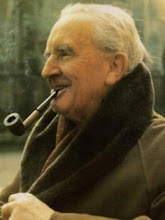
Fingolfin rode north with all speed, and all fled before his face, for by seeing the light of his eyes many thought that Oromë himself was come. He rode northwards until he came to the brazen doors of Angband, and he sounded his horn, and challenged Morgoth to single combat. And Morgoth came.
Even from his vast subterranean throne he came, and the rumour of his approach could be heard and felt as tremors in the earth. It is said that he did not want to come forth, for he was craven, but he could not refuse the challenge in front of his thegns and captains, for Fingolfin named him coward and wielder of thralls. And as he came forth from the doors of Hell, he seemed tall like a tower, clad in Iron, and his shield cast a dark shadow over the Elven-king like a stormcloud. Fingolfin gleamed silver in defiance and he drew his sword Ringil in challenge.
Then Morgoth hurled aloft Grond, the Hammer of the Underworld, and aimed it at the Elven-king, who sprang aside, and it rent a mighty pit into the earth from which fire and poisonous fumes issued. Morgoth essayed to beat down Fingolfin many times, and many times Fingolfin sprang aside, and he wounded Morgoth with seven wounds, and seven times Morgoth cried in anguish, whereat his servants in the deeps of Hell fell upon their faces in dismay.
But at last the King grew weary, and Morgoth crushed him to the ground with his black shield for the last time and he stumbled, and Morgoth set his foot upon his neck so as to kill him, but with his last breath he smote the foot with Ringil and the blood which flowed from that wound filled the pits around him.
Thus died Fingolfin son of Fëanor, mightiest of the Noldor in the Elder Days. The Elves do not sing of that confrontation, for their sorrow is too deep, but it is still remembered in Elven lore, for Thorondor, King of the Eagles, was come, and rescuing the body of Fingolfin from Morgoth (who broke it and would cast it to his wolves) and marring his face, he flew far above the darts of the Orcs and came to Turgon in Gondolin. There, in the northern peaks of the Encircling Mountains, he was laid to rest by Turgon, who raised a cairn over his body. In sorrow therefore, Fingon took up the kingship of the Noldor and great was the lamentation of the Elves.
The above image is of course by Ted Nasmith, and depicts the duel between Fingolfin and the Dark Lord. I have never been personally able to imagine what Morgoth (or indeed Sauron) looked like (Sauron did not, incidentally, look like a giant floating eyeball wreathed in fire and what looks like lightning as is portrayed in the films!), the descriptions given are vague - that he was ''monstrous,'' or ''terrible to behold'' etc. I tend to think that maybe he matched Dante's description of Satan in the Inferno (except without three faces). What do readers think?

Patricius, I have just given you this award... have fun!
ReplyDeleteIs that a crucifix that Fingolfin is wearing whilst challenging Morgoth ? He wouldn't be allowed to wear that these days !!!!! It's a Health & Safety issue, you see. It might swing round and catch somebody in the eye. And, as for that humungous hammer that Morgoth is swinging around. . .
ReplyDeletenot son of Fëanor, brother.
ReplyDelete